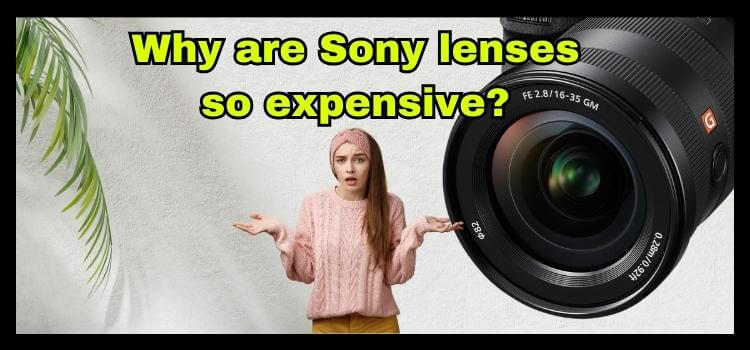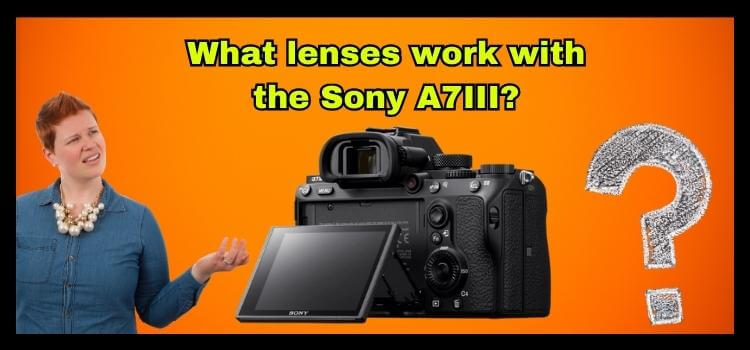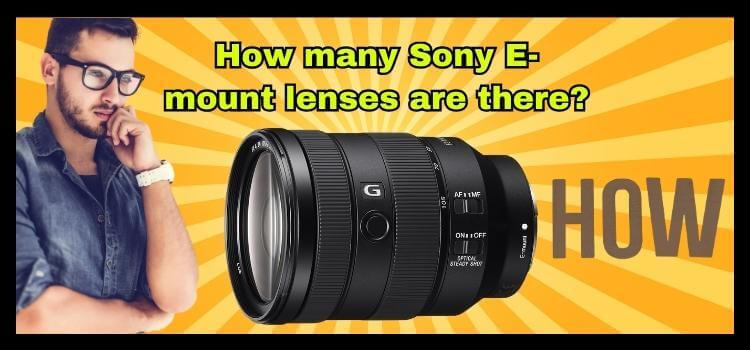As an Amazon Associate I earn from qualifying purchases.

Have you ever wondered why Sony lenses are so expensive? Photography is undoubtedly captivating but often comes with a hefty price tag, especially for top-tier lenses. In this article, we will dive into the fascinating realm of photography equipment to unravel why Sony lenses are so expensive. We’ll explore the factors contributing to their premium pricing and highlight what makes them stand out in optics.
Why are Sony lenses so expensive?
Sony lenses often cost more than lenses from other brands. This happens for several reasons:
High-Quality Build
Sony lenses are made with top-notch materials and components. Many have particular lens elements that reduce image distortion, enhancing picture quality. These unique elements are expensive to produce.
Advanced Features
Sony lenses often have advanced features like fast autofocus, weather sealing, and image stabilization. These extras make the lenses perform better but also raise their prices.
Limited Alternatives
Sony is relatively new to the camera market, so there are fewer third-party lens options for Sony cameras. This gives Sony more control over pricing.
High Demand
Sony cameras are popular, and there’s a significant demand for lenses that work with them. This strong demand leads to higher prices for Sony lenses.
Range of choices:
Not all Sony lenses are expensive. Sony offers budget-friendly options, especially for APS-C cameras. However, high-end lenses, like the G Master series, can be pricey.
The technology behind Sony lenses
Modern technology supports Sony’s reputation for excellence:
Advanced lens elements
Sony lenses use high-tech elements like aspherical elements, low-dispersion glass, and special coatings. These elements improve image quality by reducing distortion and color issues.
Precise Autofocus
Sony’s autofocus systems are known for accuracy and speed. Developing and integrating these systems takes a lot of research and development, which adds to costs.
Image Stabilization
Many Sony lenses have image stabilization to counter shaky hands and get sharper images. This technology raises costs.
Weather Protection
Sony lenses often have weather sealing, making them durable in various conditions. This is a plus for longevity, but it also increases production expenses.
Craftsmanship and quality control
Sony ensures high quality:
Hand-Assembled Parts
Some Sony lenses are hand-assembled by skilled workers. This adds precision but also costs.
Rigorous Testing
Every Sony lens undergoes strict testing to meet quality standards, ensuring reliability and high performance.
Brand Reputation
Sony’s legacy adds to costs:
History of Excellence
Sony’s commitment to quality and innovation makes it a premium brand.
Professional Use
Professional photographers often choose Sony lenses, boosting the brand’s reputation and prices.
Resale Value
Sony lenses hold their value over time, making them a good investment.
The Best in Optical Engineering
Top-Quality Glass
Sony uses top-tier glass for exceptional clarity and sharpness. This high-quality glass raises manufacturing costs.
Cutting-Edge Technology
Sony lenses have advanced technologies like aspherical elements and coatings. These innovations enhance image quality but come at a price.
Precise Manufacturing
Sony lenses often have complex designs with multiple elements. This requires precise manufacturing, which adds to costs.
Compatibility and Options
Interchangeability
Sony lenses work with many Sony and non-Sony camera bodies. This flexibility adds value but also requires extra engineering.
A wide selection
Sony offers many lens choices, requiring more production and research.
Conclusion
In conclusion, the question of why Sony lenses are so expensive can be addressed by considering the meticulous craftsmanship, cutting-edge technology, premium materials, and unmatched optical performance that Sony pours into its lenses. While the investment may seem substantial, it’s a testament to the commitment to providing photographers with tools that elevate their craft. So, the next time you ponder, Why are Sony lenses so expensive? Remember that you’re not just purchasing a piece of glass; you’re investing in your passion for photography and the pursuit of capturing moments in stunning clarity and detail.
FAQs (Frequently Asked Questions)
Yes, there are cheaper alternatives to Sony lenses available on the market. Many third-party lens manufacturers offer options that can provide good quality at a lower price point. However, it’s essential to research and compare these alternatives to ensure they meet your specific photography needs and quality expectations.
Yes, Sony lenses tend to hold their value well over time. Sony lenses are known for their quality and performance, making them highly valued in the resale market. Investing in a Sony lens is a long-term investment, as you may recover a significant portion of your initial purchase price when selling it later.
Third-party lenses can be a cost-effective alternative to Sony lenses, depending on your photography requirements and budget. Some third-party manufacturers produce lenses that offer excellent performance and value for money. However, it’s crucial to research and read reviews to ensure compatibility and quality.
Yes, using Sony lenses on cameras from different brands is possible, but it typically requires an adapter. These adapters allow you to mount Sony lenses on non-Sony cameras. However, some features and functionalities may be limited when using an adapter; It’s vital to assess compatibility and performance carefully.
When considering investing in a Sony lens, it is essential to consider several factors:
Photography Style: Consider your specific photography style, such as portrait, landscape, wildlife, or macro photography, and choose a lens that suits your needs.
Focal Length: Focal length determines the lens’s field of view. Select a lens with an appropriate focal length for your photographic subjects.
Aperture: The lens’s aperture affects depth of field and low-light performance. A lower f-number creates a shallower depth of field and is helpful in low-light conditions.
Budget: Determine your budget and explore Sony’s range of lenses within your price range. Sony offers lenses for various budgets, so you’ll likely find an option that fits.
Compatibility: Make sure your lens is compatible with your camera model. Check for compatibility information on Sony’s website or consult a camera expert.
Brand Reputation: Consider Sony’s reputation for producing high-quality lenses. Investing in a reputable brand often guarantees reliability and performance.
Reviews and recommendations: Read reviews and seek submissions from photographers with experience with the specific lens you’re interested in. Real-world experiences can provide valuable insights.
Related Post
Amazon and the Amazon logo are trademarks of Amazon.com, Inc, or its affiliates.



Leave a Reply